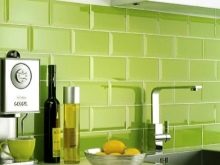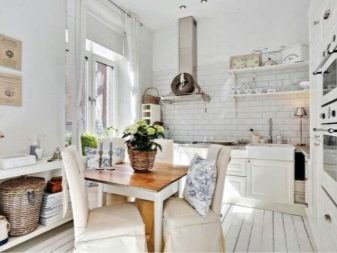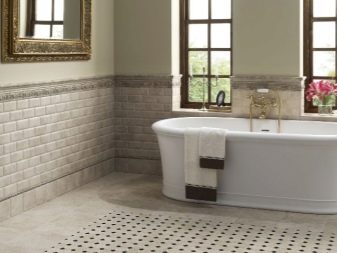Tile "hog": features and methods of installation

Some types of tiles stand out from others for their unique appearance. One of these options is the popular "hog" tile, which you need to know about the features and methods of installation.
What it is?
Tile is a material with many advantages. That is why it is often used for decoration of premises in apartments and country houses. In addition to strength, moisture resistance and durability, the tile has excellent decorative properties. A type of tile with a funny name "hog" allows you to achieve an interesting visual effect. It appeared at the end of the 19th century, however, thanks to its original form, it still has many fans.


The name was obtained due to the technological features of the creation process. When the solution entered the mold, two holes could be observed. Outwardly, it resembled the stigma of a pig, therefore the product began to be called "hog". Initially, the material was used only for facades. Then they began to use it to decorate the Paris Metro. This is how the second name of the tile appeared - "metro".
Today "hog" is actively used in interior decoration (mainly kitchens and bathrooms). The texture of the material has changed, the color range has expanded, the overall look has become more elegant and attractive. Only the characteristic convex shape of the products remained unchanged, providing an imitation of brickwork.


Peculiarities
Modern manufacturers offer various options for this type of tile. A distinctive feature that unites them is the rectangular shape, reminiscent of a brick. Also, most products of this type have a bevel of the edges of the products at an angle of 45 degrees. As for the color scheme, the "pig" is usually presented in monochrome versions, although there are exceptions.

The popularity of such products is due to their numerous advantages, including:
- Strength. A special manufacturing technology provides increased hardness and resistance of the material to mechanical stress.
- Durability. Due to the resistance of the tile to temperature extremes, high humidity and chemicals, it is able to delight the owners for many years. The tile does not tarnish, retaining its visual appeal and allowing you to save on repair work.
- Variety of design solutions. Even in a one-color version, the "hog" has a spectacular look, suitable for any style of interior. A variety of colors allows you to choose an option for every taste. You can also combine tiles with colored borders, combine two contrasting shades, and even combine "hog" with regular square or rectangular tiles. With the right choice of tones and sizes, you can get a harmonious and interesting design.

As for the shortcomings, there is only one. The special shape of the tiles makes installation a little difficult. It is especially difficult to place tiles in corners.
There are two ways to resolve the issue:
- hire professional craftsmen for work;
- choose a flat section of the wall for decoration. In the absence of joints, it will be easy for you to lay the tiles beautifully, making it an effective touch of the room.
Varieties
The classic "hog" is made in one color. These are laconic strict tones (white, black, gray), and delicate pastel shades, and bright colors.In this case, the surface can be matte, glossy or even pearlescent. Translucent glass tiles, gold and silver products look interesting. Also, modern manufacturers produce tiles that imitate marble or real brick. Some brands offer a "hog" with a pattern. Most often these are geometric shapes and abstract patterns.

Most models of this type are available with a chamfer, providing the volumetric coverage. Surfaces designed in this way look original even when using only one shade. Also on sale you can find flat-shaped "hog". To make such masonry more expressive, grout in a contrasting color is often used.

Dimensions (edit)
The size of the tiles is chosen based on the size of the room and personal taste. The smallest products have dimensions of 7.5x10 cm or 8x10 cm, however, the 10x20 cm option is still more popular. This choice is optimal for any design. Large elements visually reduce the area of the room, however, larger tiles can be used in spacious kitchens. Usually it has a size of 10x30 cm.
Sometimes tiles of different sizes are combined in the same design.For example: a duet of small tiles and large “bricks” 30x10 cm will help to create a very interesting composition. Keep in mind that such experiments are best left to professional designers.


Colors
Snow-white tiles are a classic. Such a versatile solution suits any interior style, because white is combined with any other shades. In addition, white is able to visually expand the boundaries of the room, which is especially important for bathrooms.
Black tiles it is used less often, although it looks no less impressive. This option is more suitable for spacious rooms. Black also works great as an accent, especially when combined with white.

Gray shades are neutral. If you have a bright kitchen set, but you do not know what finish to choose in order to get a harmonious and relatively calm interior, you can safely choose light gray tiles. This option is also suitable for connoisseurs of minimalism. It, combined with white and black colors, creates a laconic and stylish environment.


Beige tile - an excellent choice for those who prefer warm colors. Like white, it visually fills the room with light and makes it more spacious. Unlike austere snow-white tiles, this "hog" makes the atmosphere cozy and homely. In the kitchen, beige tones can be successfully combined with chocolate. In the bathroom, beige and pink colors will look great, as well as a combination of beige with white, milky or gray tones.

Blue ideal for bathrooms. It is associated with sea freshness and the vast expanse of clear sky. For the kitchen, such a color scheme is not the best choice, since the coldness of the shade does not promote appetite, but with the right choice of furnishings and accessories, such a dining area can be made beautiful and cozy.



Red color prefer dynamic natures. It is not recommended to decorate all walls of the room with such tiles. So you run the risk of getting too aggressive and even repulsive interior. In addition, the abundance of bright colors will lead to unnecessary eye strain. As an accent element, such a "hog" will be very useful. The best are the red and white and red and black variations.


Green color has a calming effect, however, designers do not recommend using bright green tones for wall decoration. Better opt for muted shades. The same goes for blue.



Turquoise and purple shades should be used with care. It is better to combine them with other, calmer tones as an effective accent touch.


Yellow and orange create a summer, sunny mood. When choosing tiles of such juicy shades, be careful.Think if you will not get tired of such brightness in a couple of weeks, because usually the tiles are laid with the expectation of many years of operation.
In addition to plain tiles, color options with various patterns are available for sale. Tile "marbled" looks noble. Connoisseurs of loft style will love the brick-like design that fits perfectly into this concept. Those looking to create a romantic atmosphere can look for tiles with floral motifs.



Textures
Modern manufacturers offer "hog" with glossy and matte textures. Usually the first option is chosen for the bathroom. Gloss reflects streams of light, visually expanding the space and making the coating especially effective. However, matte tiles look no worse, and even surpasses glossy counterparts in practicality. On matte tiles, drips and traces of water are not so noticeable. In addition, these tiles are easier to maintain. It is also worth noting the variety of matte "hog" designs. If gloss is more often presented in monochrome colors, then matte surfaces can have various prints, as well as imitate marble, brick and other materials.


How to choose?
When choosing wall ceramic tiles, it is important to consider not only personal preferences, but also the purpose of the material. For the bathroom and toilet, it is better to choose a material of a calm shade. To decorate a kitchen apron, you can purchase a brighter option. So that the wall decoration does not stand out from the general design concept, it is also worth considering the style of the room.
- Art deco style welcomes the combination of sophistication and outrageousness. Here, the classic black and white range can be complemented by purple, pink and even turquoise touches. Black tiles, accentuated by gilding, look spectacular. The technique of contrasting black and white is often used. Usually, borders are used for this, but sometimes more daring "checkerboard" options are used.

- Into the Scandinavian interior tiles of white, gray, beige, brown colors will perfectly fit. The option "under a brick" will also be appropriate.
- For indoor walls provence or shabby chic a snow-white "hog" will do. Imitation of aged material will also come in handy.


- Loft - another style in which the effect of facade decoration is also welcomed indoors. Here, tiles can decorate not only a bathroom and a kitchen, but also a corridor and rooms. The characteristic negligence and roughness is achieved with the help of tiles with a matte surface. In this case, dark colors are preferred (black, brown, gray). Regardless of the color of the tiles, the joints are filled with dark gray or black grout. Imitation of real brick would be the perfect choice here.
- In a classic interior white, beige, brown, gray tiles will look good. There is no place for bright colors. On the contrary, the color scheme should be soft and calm. Graceful ornaments are allowed.
- In a modern setting any options are possible: delicate pastel colors or bright dynamic colors - the choice depends only on personal taste. Also, do not forget to consider the compatibility of tiles on the floor and furniture. All shades should be in harmony with each other. If you are afraid that the tiles located near the stove will be difficult to maintain, you can protect this area with a transparent wall panel.
When choosing a manufacturer, focus on customer reviews. So you can choose really high-quality material that will delight you for many years.


How to stack?
Depending on the tile laying technology, you can get different design options. There are six main ways to decorate walls with hog tiles.
- The classic method. The tiles are placed on the wall so that the final version resembles brickwork. Each next row is shifted by ½. The result is a pretty interesting design.Even a non-professional can cope with the work, so this method is chosen more often than others.
- Horizontal styling. Here all the tiles are positioned exactly one below the other. Despite the seeming simplicity, this method is only capable of experienced craftsmen. In this case, a beautiful styling can be achieved only under the condition of the most even and neat tile joints.


- "Stacks". This technology allows you to visually increase the height of the room. The modules are located with the narrow side up, while the accuracy and consistency of strict parallel are extremely important. This method is not very popular, it is only suitable for extreme cases.
- "Chess". Here the tiles fit into two modules. The first is located vertically, the second horizontally. This technology is also rarely used.


- Diagonally. The diagonal placement of the "hog" is the most effective option. In addition, it is able to visually expand the room. Laying tiles in this way is not easy.
- "Herringbone". This technology resembles the laying of parquet. The result of finishing the premises in this way is impressive, but the process itself is very complicated. In this case, it is necessary to cut each tile at a 45 degree angle (burr).



Regardless of the installation method, there are also a few key points to keep in mind:
- The peculiarity of the "hog" is rather large thickness and weight, therefore, the surface for laying such a tile is prepared as for painting. For greater reliability, the glue is applied not only to the wall surface, but also to the tiles themselves.
- Another important nuance is the inadmissibility of large tile joints. The optimum width of the gap between products does not exceed 2 mm.
- The tricky part is the design of the corners. To achieve the perfect result, you must carefully align the walls in advance. It is also worth paying attention to the accuracy of trimming the outer corners and choosing the inner corners as a starting point for styling.
- In order to properly install sockets and switches, it is important to make preliminary calculations. Choose places for such parts taking into account the location of the tile itself.
- All joints are treated with grout or sealant. Due to the peculiarities of the appearance of the "hog", even light tiles with a dark grout will burn off perfectly, so when choosing a color, be guided by the style of the interior and your artistic taste.


Examples in the interior
Gray-beige tiles with an exquisite carved border are ideal for a classic bathroom. Gold-plated details complement the interior, making it "expensive" and stylish. Floor decoration to match the walls is the right solution to create a harmonious environment.
A cool beige tone is also appropriate in the kitchen. This tile goes well with a wooden countertop and with snow-white headset cabinets.


Lovers of bright colors can decide to decorate the kitchen in red tones. The perfect combination of red, white and black creates a striking contrasting environment. "Boar" of an unusual square shape with a characteristic bevel fits perfectly into the modern style.

The combination of the classic white "hog" with square colored tiles is an interesting design move. Competent selection of a pattern that matches the tone of the headset ensures the creation of an ideal interior with a unique character.
A strict yet stylish design is created by a combination of solid white tiles and tiles with a gray print. Small but cute accessories add brightness to the room.


For information on how to make and use a template for cutting tiles "hog", see below.













The comment was sent successfully.